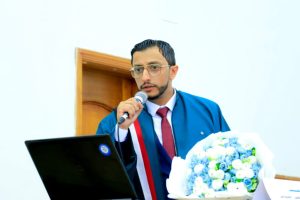Sunday August 25th, 2024, i.e. Muharram 2nd, 1446H, Amal Abdul-Kareem Qassem AL-MUHALEL obtained the Master degree in Basic Sciences with an Excellent average of 95%, Majo
- Categories Letters and Promotions - Graduate Studies, news, Regulations - Postgraduate Studies
- Date September 7, 2024

Sunday August 25th, 2024, i.e. Muharram 2nd, 1446H, Amal Abdul-Kareem Qassem AL-MUHALEL obtained the Master degree in Basic Sciences with an Excellent average of 95%, Major: Basic Medical and Dental Sciences from Faculty of dentistry, Sanaa University, for her dissertation entitled: Evaluation of Effectiveness of Adding Ciprofloxacin to Calcium Hydroxide versus Adding Saussurea Costus to Calcium Hydroxide Medicament Against Bacterial Biofilm in Root Canal Treatment-Vivo Study. The discussing committee was formed of: Professor Dr. Hasan Abdel-Wahab AL-SHAMAHI, Principle Supervisor, and Professor Dr. Abdel-Wahab AL-KHAWLANI, Internal Examiner and Head of Committee, and Associated Professor Fadhel AL-SANABANI, External Examiner and Committee Member. The dissertation aims at determining the effectiveness of adding Ciprofloxacin to Calcium Hydroxide versus Adding Saussurea Costus to Calcium Hydroxide Medicament, given to cases suffering from Bacterial Biofilm in Root Canal—with no side effects.
The study comes out with some results, of which: Intragroup analysis revealed a significant reduction in the number of intracanal bacterial cells from Sample 1 to Sample 2 in all medication groups (P<0.0001). Although there was no significant difference amongst the groups when comparing quantitative S1 or S2 data, there were significantly lower bacterial counts in the Ca(OH)2 + Ciprofloxacin group (11.9±29 CFU) than the Saussurea costus extract Ca(OH)2 34.05±21.8 at Sample 3. The most isolated bacteria in Sample 1 and Sample 2 were Staphylococcus aureus (58.6%, 51.4%), followed by Klebsiella species (27.1%, 18.6%), Escherichia Coli (25.7%, 17.1%), Enterococcus faecalis (22.9%, 15.7%) and Pseudomonas aeruginosa (21.4%, 12.9%).
Conclusions of the study: The addition of Ciprofloxacin to Ca (OH)2 and Saussurea Costus-Ca (OH)2 provided further antibacterial effectiveness when used as intracanal medicament in vivo during root canal treatment.
The researcher presents a number of recommendations at the end of the dissertation, of which the need for a particular study on anaerobic Bacteria.
Attendees of the session were a number of academics, researchers, students of the field, the researcher’s colleagues and some of family members.









